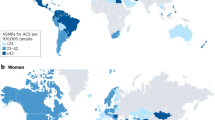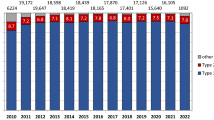Abstract
The existence of a universal definition of myocardial infarction—which involves classification into multiple subtypes—has promoted the use of standard diagnostic criteria across the world. However, this classification has not been applied consistently in practice and is perceived by some as too complicated. Where there is diagnostic uncertainty, patients have worse outcomes. This uncertainty has also impacted on the validity of the diagnosis of myocardial infarction in clinical trials. To address these issues and to encourage clinicians to recognize that different mechanisms of myocardial infarction have differing treatment implications, we propose an alternative clinical classification for consideration; one that recognizes that myocardial infarction can arise spontaneously, secondary to another condition, or as a complication of a cardiac procedure. This classification is aligned with clinical practice and proposes more objective and specific diagnostic criteria that, if agreed by international consensus, could reduce diagnostic uncertainty in practice and research.
This is a preview of subscription content, access via your institution
Access options
Access Nature and 54 other Nature Portfolio journals
Get Nature+, our best-value online-access subscription
$29.99 / 30 days
cancel any time
Subscribe to this journal
Receive 12 print issues and online access
$209.00 per year
only $17.42 per issue
Buy this article
- Purchase on Springer Link
- Instant access to full article PDF
Prices may be subject to local taxes which are calculated during checkout

Similar content being viewed by others
References
The Joint European Society of Cardiology/American College of Cardiology Committee. Myocardial infarction redefined—a consensus document of The Joint European Society of Cardiology/American College of Cardiology Committee for the redefinition of myocardial infarction. Eur. Heart J. 21, 1502–1513 (2000).
Thygesen, K. et al. Universal definition of myocardial infarction. Circulation 116, 2634–2653 (2007).
Thygesen, K. et al. Third universal definition of myocardial infarction. Circulation 126, 2020–2035 (2012).
Thygesen, K. et al. Fourth universal definition of myocardial infarction. Circulation 138, e618–e651 (2018).
Gard, A. et al. Diagnosing type 2 myocardial infarction in clinical routine. A validation study. Scand. Cardiovasc. J. 53, 259–265 (2019).
Gregson, J. et al. Implications of alternative definitions of peri-procedural myocardial infarction after coronary revascularization. J. Am. Coll. Cardiol. 76, 1609–1621 (2020).
Neumann, J. T. et al. Discrimination of patients with type 2 myocardial infarction. Eur. Heart J. 38, 3514–3520 (2017).
Chapman, A. R. et al. High-sensitivity cardiac troponin and the universal definition of myocardial infarction. Circulation 141, 161–171 (2020).
Hammarsten, O., Mair, J., Möckel, M., Lindahl, B. & Jaffe, A. S. Possible mechanisms behind cardiac troponin elevations. Biomarkers 23, 725–734 (2018).
Árnadóttir, A. et al. Temporal release of high-sensitivity cardiac troponin T and I and copeptin after brief induced coronary artery balloon occlusion in humans. Circulation 143, 1095–1104 (2021).
Shah, A. S. et al. High-sensitivity cardiac troponin I at presentation in patients with suspected acute coronary syndrome: a cohort study. Lancet 386, 2481–2488 (2015).
Devereaux, P. J. et al. High-sensitivity troponin I after cardiac surgery and 30-day mortality. N. Engl. J. Med. 386, 827–836 (2022).
Hinton, J. et al. Incidence and 1-year outcome of periprocedural myocardial infarction following cardiac surgery: are the Universal Definition and Society for Cardiovascular Angiography and Intervention criteria fit for purpose? Eur. J. Cardiothorac. Surg. 62, ezac019 (2022).
Zeitouni, M. et al. Periprocedural myocardial infarction and injury in elective coronary stenting. Eur. Heart J. 39, 1100–1109 (2018).
Saaby, L. et al. Classification of myocardial infarction: frequency and features of type 2 myocardial infarction. Am. J. Med. 126, 789–797 (2013).
McCarthy, C. P. et al. Patient characteristics and clinical outcomes of type 1 versus type 2 myocardial infarction. J. Am. Coll. Cardiol. 77, 848–857 (2021).
Eggers, K. M., Baron, T., Chapman, A. R., Gard, A. & Lindahl, B. Management and outcome trends in type 2 myocardial infarction: an investigation from the SWEDEHEART registry. Sci. Rep. 13, 7194 (2023).
Bularga, A. et al. Coronary artery and cardiac disease in patients with type 2 myocardial infarction: a prospective cohort study. Circulation 145, 1188–1200 (2022).
Herrick, J. B. Certain clinical features of sudden obstruction of the coronary arteries. JAMA 59, 2015–2020 (1912).
Chapman, A. R. et al. Long-term outcomes in patients with type 2 myocardial infarction and myocardial injury. Circulation 137, 1236–1245 (2018).
Sepehrvand, N. et al. Alignment of site versus adjudication committee-based diagnosis with patient outcomes: insights from the providing rapid out of hospital acute cardiovascular treatment 3 trial. Clin. Trials 13, 140–148 (2016).
Gard, A., Lindahl, B. & Baron, T. Impact of clinical diagnosis of myocardial infarction in patients with elevated cardiac troponin. Heart https://doi.org/10.1136/heartjnl-2022-322298 (2023).
DeFilippis, A. P. et al. Assessment and treatment of patients with type 2 myocardial infarction and acute nonischemic myocardial injury. Circulation 140, 1661–1678 (2019).
Mueller, C. et al. Multicenter evaluation of a 0-hour/1-hour algorithm in the diagnosis of myocardial infarction with high-sensitivity cardiac troponin T. Ann. Emerg. Med. 68, 76–87 (2016).
Ljung, L. et al. A rule-out strategy based on high-sensitivity troponin and HEART score reduces hospital admissions. Ann. Emerg. Med. 73, 491–499 (2019).
Anand, A. et al. High-sensitivity cardiac troponin on presentation to rule out myocardial infarction: a stepped-wedge cluster randomized controlled trial. Circulation 143, 2214–2224 (2021).
Doudesis, D. et al. Machine learning for diagnosis of myocardial infarction using cardiac troponin concentrations. Nat. Med. 29, 1201–1210 (2023).
Spitzer, E. et al. Critical appraisal of contemporary clinical endpoint definitions in coronary intervention trials: a guidance document. JACC Cardiovasc. Interv. 12, 805–819 (2019).
de Lemos, J. A., Newby, L. K. & Mills, N. L. A proposal for modest revision of the definition of type 1 and type 2 myocardial infarction. Circulation 140, 1773–1775 (2019).
Lee, K. K. et al. Prevalence, determinants and clinical associations of high-sensitivity cardiac troponin in patients attending emergency departments. Am. J. Med. 132, 110.e8–110.e21 (2019).
Baron, T. et al. Impact on long-term mortality of presence of obstructive coronary artery disease and classification of myocardial infarction. Am. J. Med. 129, 398–406 (2016).
Garcia-Garcia, H. M. et al. Standardized end point definitions for coronary intervention trials: The Academic Research Consortium-2 consensus document. Circulation 137, 2635–2650 (2018).
Acknowledgements
B.L. was a member of the Task Force for the Universal Definition of Myocardial Infarction. N.L.M. is supported by a Chair Award (CH/F/21/90010), Programme Grant (RG/20/10/34966) and a Research Excellent Award (RE/18/5/34216) from the British Heart Foundation.
Author information
Authors and Affiliations
Contributions
B.L. and N.L.M. drafted and revised the manuscript critically for important intellectual content, provided approval of the final version to be published and are accountable for the work.
Corresponding author
Ethics declarations
Competing interests
B.L. declares no competing interests. N.L.M. reports research grants awarded to the University of Edinburgh from Abbott Diagnostics and Siemens Healthineers, and honoraria from Abbott Diagnostics, Siemens Healthineers, Roche Diagnostics and LumiraDx.
Peer review
Peer review information
Nature Medicine thanks Adnan Kastrati and the other, anonymous, reviewer(s) for their contribution to the peer review of this work. Primary Handling Editor: Karen O’Leary, in collaboration with the Nature Medicine team.
Additional information
Publisher’s note Springer Nature remains neutral with regard to jurisdictional claims in published maps and institutional affiliations.
Rights and permissions
Springer Nature or its licensor (e.g. a society or other partner) holds exclusive rights to this article under a publishing agreement with the author(s) or other rightsholder(s); author self-archiving of the accepted manuscript version of this article is solely governed by the terms of such publishing agreement and applicable law.
About this article
Cite this article
Lindahl, B., Mills, N.L. A new clinical classification of acute myocardial infarction. Nat Med 29, 2200–2205 (2023). https://doi.org/10.1038/s41591-023-02513-2
Received:
Accepted:
Published:
Issue Date:
DOI: https://doi.org/10.1038/s41591-023-02513-2



